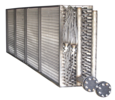The role of condenser coils in HVAC systems

A condenser coil is a type of heat exchanger, which transfers heat between two mediums, such as liquid to gas. Condenser coils are used for a variety of applications, from household appliances, like refrigerators and central air conditioners, to large industrial processes. The condenser coil is made up of internal tubing used to manage the process of transferring heat or cooled air. Many condenser coils are flat, but others are U shaped, L shaped, or whatever shape pulls more air through the HVAC system. For example, a central air conditioning system has a condenser coil that wraps around the sides of the condenser unit, which is located outside the building.
In HVAC systems, water, steam, or a chemical refrigerant is used to facilitate the heat exchange. The refrigerant goes from the chiller through the condenser coil, which acts as an evaporator, cooling the inside of the building, then moving outside to the condenser unit. This process is repeated to continually supply the building (or refrigerator or other system) with cooled air. Most condenser units are self-maintaining.The first sign there may be a problem with the condenser coil is when the temperature of the cooled air is warmer than the thermostat setting. Check the amount of refrigerant in the system to make sure there is enough coolant. If the coolant level is OK, it might be time to replace the condenser coil. Check your local guidelines to learn about the proper disposal of old condenser coils.The refrigerant of choice for residential heat pump and air-conditioning systems for decades was R-22 (Freon). Due to growing environmental concerns, the EPA mandated the phaseout of R-22 through the Clean Air Act. As R-22 is phased out, non-ozone-depleting alternative refrigerants include R-134A, R-404A, R-407A, R-410A, R-502, R-507, and R-517.
The manufacture of new systems using R-22 refrigerant ended in 2010, and the production of R-22 must cease by 2020. Existing units using R-22 can continue to be serviced with R-22, and there is no EPA requirement to change or convert R-22 units for use with a non-ozone-depleting substitute refrigerant. EPA.Gov
